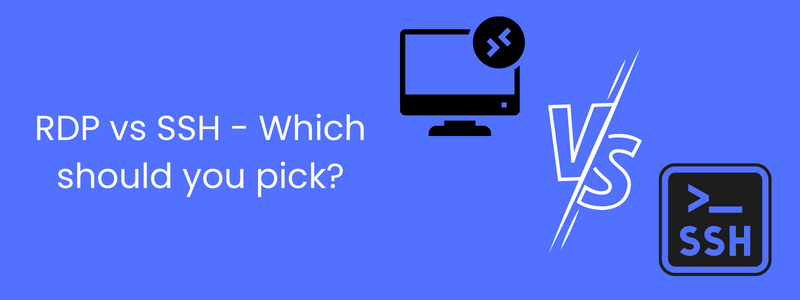RDP and SSH – Which should you pick?

Why Compare RDP and SSH?
With a growing remote workforce, IT administrators must allow users to connect to servers from anywhere in the world without jeopardizing security. Both the RDP and SSH protocols are used to authenticate remote server access. These servers are increasingly cloud-based Infrastructure-as-a-Service (IaaS). However, both protocols can be used to connect to on-premises servers.
RDP: What is it and how does it operate?
Windows OS makes use of the Remote Desktop Protocol. It’s used to connect to physical or virtual servers. In contrast to SSH, RDP has a graphical user interface. RDP is intended to connect to another machine via the internet. Its function is to send data from the output device to the input device, such as monitor screen/display, mouse, and keyboard logs (local machine).
The RDP protocol is used to provide remote access over a dedicated network channel. An RDP-enabled application or service packages the data to be communicated, and the Microsoft Communications Service routes the data to an RDP channel. The operating system then encrypts the RDP data and attaches it to a frame for transmission.
The Terminal Server Device Redirector Driver is composed of sub-components such as the RDP driver, which handles all RDP protocol activity such as user interfaces, transfers, encryption, compression, and framing, and packages the protocol for transmission over a TCP/IP network.
SSH: What is it and how does it operate?
SSH, or Secure Shell protocol, is used to run secure network services over insecure networks. The SSH protocol is implemented as a separate client and server application that runs as an application on top of the TCP/IP layer. Before establishing a secure connection, enable authentication and protocol negotiation. SSH, in essence, provides the following services: Cryptographic host authentication and User authentication.
– Secure encryption.
– Strong data integrity safeguards.
– Data channel multi-tunneling
With such features, SSH can be used for secure remote (SR) logins, SR command execution, and SR file transfer. Along with cryptographic key control, TCP port forwarding, and authentication agents, it also includes data compression and access control components.
To establish an SSH connection, you’ll need two components: a client and the corresponding server-side component. The client initiates the connection using the provided remote host information and, if the credentials are verified, establishes the encrypted connection. The server monitors the network using a dedicated TCP/IT port, waiting for client connection requests. For a remote connection, SSH requires the client to provide proper authentication. Once the credentials provided are validated, the client can connect and issue SSH commands.
A Major Difference between RDP and SSH
RDP and SSH are two separate solutions for connecting to remote computer systems.
• RDP provides users with a tool for managing remote connections via a graphical user interface.
• SSH provides a Secure Shell and is used for text-based remote machine management.
One may be better suited to your business objectives than the other depending on your reason for using the tool.
Comparing RDP vs SSH
Connecting to remote computer systems is a fairly routine task in the world of information technology (IT). Because of the recent increase in the number of remote workers, system administrators have been forced to provide secure access using the available communication protocols. The Secure Shell (SSH) protocol and the Windows Remote Desktop Protocol are two popular solutions for providing authenticated remote access to infrastructure elements (RDP).
Choosing between RDP and SSH
The reason you need remote access and the types of activities you will perform will influence your decision between SSH and Remote Desktop.
The first factor to consider is the security of SSH vs. Remote Desktop. SSH’s enhanced security makes it more suitable for many situations involving sensitive data. SSH is also an excellent choice for tasks such as server configuration and software package updates on remote computers. If a GUI is not required, SSH should suffice.
The ability to provide users with a graphical interface distinguishes Remote Desktop from SSH. There are times when using a GUI is absolutely necessary, and SSH is not the right solution. Despite its latency and file transfer limitations, an RDP GUI can be just what the team needs to get things done.
In short, the option depends entirely on how the tool will be used. Though they appear to provide the same remote access functionality at first glance, as we have seen, this is not the case. To address specific usage scenarios, one solution is usually far superior to the other.
You may also like: Cloud Directory Vs Active Directory: What’s The Difference?
Conclusion
How well do you understand RDP vs SSH? After reading this post, you should have a good understanding of what RDP and SSH are, how they work, and who is safer. To summarise, RDP is much easier and less technically demanding to set up and use as a remote access tool, whereas SSH is much safer and supports much higher encryption standards than RDP.
Other remote access tools, in addition to RDP and SSH, are available to you. For instance, consider the third-party remote access software AnyViewer. Elliptic Curve Cryptography (ECC) encryption, which generates security between key pairs for public-key encryption by using the mathematics of elliptic curves, secures it. If you’re looking for remote access tools that are both secure and simple to use, AnyViewer is a good option.
We hope you like our blog. You may also like: Top Benefits of Single Sign-On (SSO)
